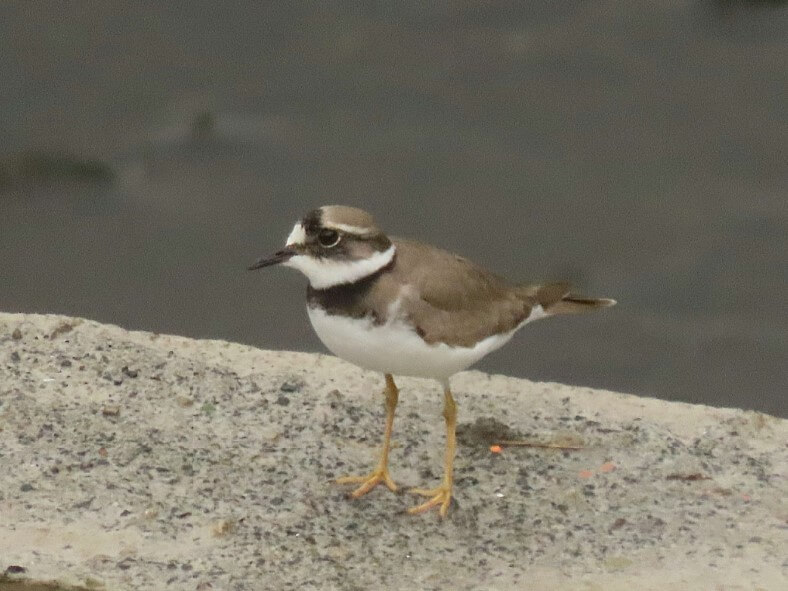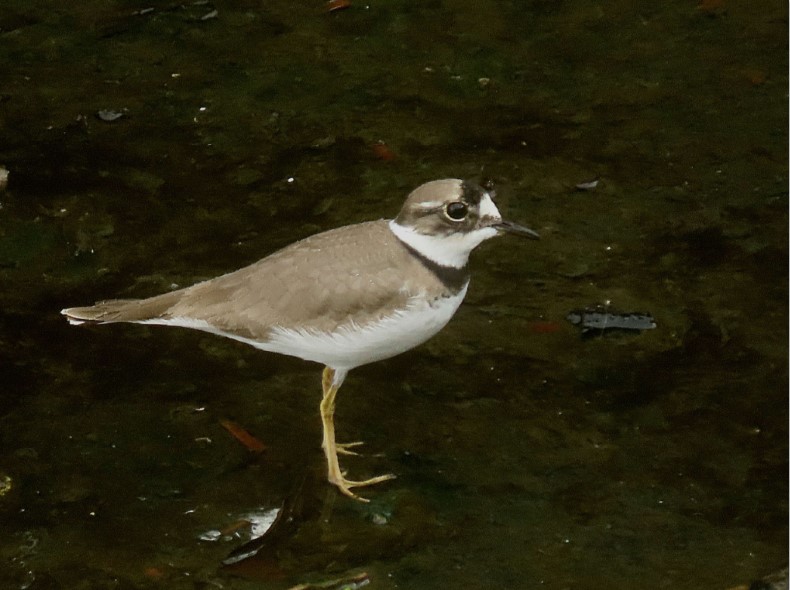
The Philippine record for the first-ever sighting of the Long-Billed Plover, a bird included in the International Union for Conservation of Nature (IUCN) Red List for Threatened Species, was confirmed by the Philippine Bird Rarities Committee to have been observed in Batanes, a protected area for wildlife.
The local sighting of the wading bird species in the family Charadriidae (Charadrius placidus) is considered rare because the migratory bird, whose breeding season starts at the end of February or early March and ends in July, is more likely to be seen in East Asian countries and has never before been recorded in the Philippines.
The country record belongs to birders Lu-Ann Fuentes-Bajarias and Amado “Mads” Bajarias Jr. with local guide Albert Patimo who together observed the Long-billed Plover during a visit to Batanes on New Year’s eve, December 31, 2022. The Committee confirmed the Philippine record two days later on January 2, 2023.
The trio of bird watchers spotted the Long-billed Plover wading on the shore, similar to other records of sightings along the shorelines of streams, rivers, rice fields, and wetlands where it feeds on aquatic insects, insect larvae, and other invertebrates.
Batanes: A Special Place
Good News Pilipinas interviewed the birders about the significance of the sighting of the Long-billed Plover. Mads Bajarias says Batanes had the right conditions for the rare sighting: the location of Batanes on the migration path of bird species that are considered “rare”, the protected status of the area, and the low human population.
“For birders, Batanes is a special place because the avifauna there has more in common with East Asia than Southeast Asia. During the seasonal winter migration that begins every September, birds from mainland Asia seeking to escape the cold conditions fly south, and often, after crossing a large body of water, let’s say the sea between Taiwan and Luzon, they will land, rest and ‘refuel’ by feeding in Batanes. This is the reason why the chance of seeing bird species that are considered ‘rare’ in the Philippines (or even taxon that have never been seen in the country like Long-billed Plover) is higher in Batanes. Its location makes it special.

“Second, the entire Batanes is a protected area. You can feel this in the behavior of wild birds–they are not as wary in Batanes as they are in the rest of the Philippines where hunting and trapping are rampant. There is a tradition of poaching pigeon chicks and caging them but there appears to be no logging, mining, quarrying, or hunting. The birds know that they are safe here. This is important because it allowed us to see the Long-billed Plover at a distance close enough to see its distinguishing features. If it had been wary of us, it would have flown away and we would have dismissed it as its more common cousin–Little Ringed Plover.
“Third, the human population density of Batanes is low compared to the rest of the country. This means there is still adequate space for migratory birds to feed and roost in without getting into close proximity with humans and human-associated predators like dogs and cats. In Luzon, natural habitats like wetlands and grasslands are being destroyed to make way for human settlements and agri farms, displacing wintering birds that need these habitats to rest and feed in during their stay here. Our sighting of Long-billed Plover was made possible by the fact that there is still adequate habitat in Batanes to support shorebirds.”
Philippine Record: Call For Closer Look Into Threatened Species
The population number of the Long-billed Plover is listed as a species of least concern on the IUCN Red List although observers have noted its global number to be decreasing and might decline rapidly in the future due to the loss of suitable breeding grounds. The Philippines is the 22nd country to have recorded the sighting of the bird, next to Bangladesh, Bhutan, Brunei, Cambodia, China, Hong Kong, India, Indonesia, Japan, Laos, Malaysia, Mongolia, Myanmar, Nepal, North Korea, Russia, South Korea, Sri Lanka, Taiwan, Thailand, and Vietnam.
“Marking and sharing country records are perhaps a way to get some to pause even if only for a bit while scrolling down the media feed. You know how the ‘charismatic species’–often large, beautiful, endangered–make you think about conservation not only of their kind but of their habitats as well? The hope is for more Filipinos to look as closely at birds, as sentinel species–what hurts them, will eventually hurt us,” said Lu-Ann Fuentes-Bajarias.
“Being everywhere, they are barometers of ecosystems’ health. And they’ve long been sounding the alarm–from their widespread populations-decline to shifting of migration timings. The Philippines being in BirdLife International’s ‘top 10 countries/territories with the greatest number of globally threatened species’ indicates already degraded habitats from forests to wetlands. The state of our natural world needs more awareness, allies, and investment,” Fuentes-Bajarias added.

Bajarias Couple: Partners for Birding and Conservation
Good News Pilipinas asked the Philippine record-making birders how they got into observing birds.
Mads Bajarias recalls being introduced to birdwatching over two decades ago when he and Lu-Ann were working for Haribon Foundation, a non-governmental organization advocating nature conservation and environmental causes.
It was when they met Tim Fisher, a British expatriate who was considered the world’s foremost expert on Philippine birds who authored several scientific papers on Philippine avifauna, wrote a photographic guide to common Philippine birds, and co-authored an illustrated field guide published by Oxford Press.
“He ran a company taking foreign birdwatchers around the Philippines to look for endemic species. Tim would sometimes lead birdwatching trips with Haribon staff and volunteers. Those trips with Tim were our formal introduction to birding,” notes Bajarias.
The introduction led to many more birdwatching trips. In 2003, the couple was recruited to join the founding members of the Wild Bird Club of the Philippines.
“This meant access to the experts who cultivated a rigor in the reporting of observations. This meant connecting with ‘birds of the same feather’ who fan the enthusiasm,” adds Lu-Ann Fuentes-Bajarias.
The fact that they are a couple who can work hybrid allows the Bajarias birders to continue their advocacy and what they enjoy.
“But we’ve also been lucky in that–being husband and wife–we’ve got a built-in buddy system to just go-and-see with little notice on our weekends and holidays. These days, like many who have transitioned into hybrid work, periodically going offline needs to be a more conscious choice, and so birding certainly helps with the so-called digital detox,” explains Fuentes-Bajarias.
“Scanning for a small, grass-dwelling songbird or an elusive wader with cryptic plumage simply demands your full attention; and even before–or even without–the actual spotting, I always feel I’ve already reaped the benefits of ‘decompression’,” she emphasizes.
Lu-Ann Fuentes-Bajarias shared on social media about the Philippine record:
“First Philippine Record: Random clips (because I’ve got ridiculously too many!) of Long-billed Plover, first seen in Batanes on the last day of 2022. Amado—who first determined in his usual dry tone that this wasn’t a plover we’ve seen before—secured that country record as my (we said in jest/challenge) December birthday-gift after all. Albert messaged just today that it’s still there!”
CHECK OUT the videos posted by Lu-Ann Fuentes-Bajarias here:
The Philippines has also recorded its first-ever sighting of the Little Black Cormorant in Zamboanga City, while the rare Philippine Dwarf Kingfisher of Mindanao was photographed for the first time in 130 years.
SEND CONGRATULATIONS in the comments below to birders Lu-Ann Fuentes-Bajarias and Amado Bajarias with local guide Albert Patimo, the Philippine record holders of the first-ever sighting of the Long-billed Plover in Batanes!
Good News Pilipinas is a Lasallian Scholarum Awardee. TELL US your good news story tips by messaging GoodNewsPilipinas.com on Facebook, Twitter, Instagram, or e-mail editor@goodnewspilipinas.com and WATCH Good News Pilipinas TV YouTube & Good News Pilipinas TikTok for more Filipino Pride stories!
The post Philippines records 1st sighting of Long-Billed Plover in Batanes appeared first on Good News Pilipinas.
Source: Good News Pilipinas
0 Comments